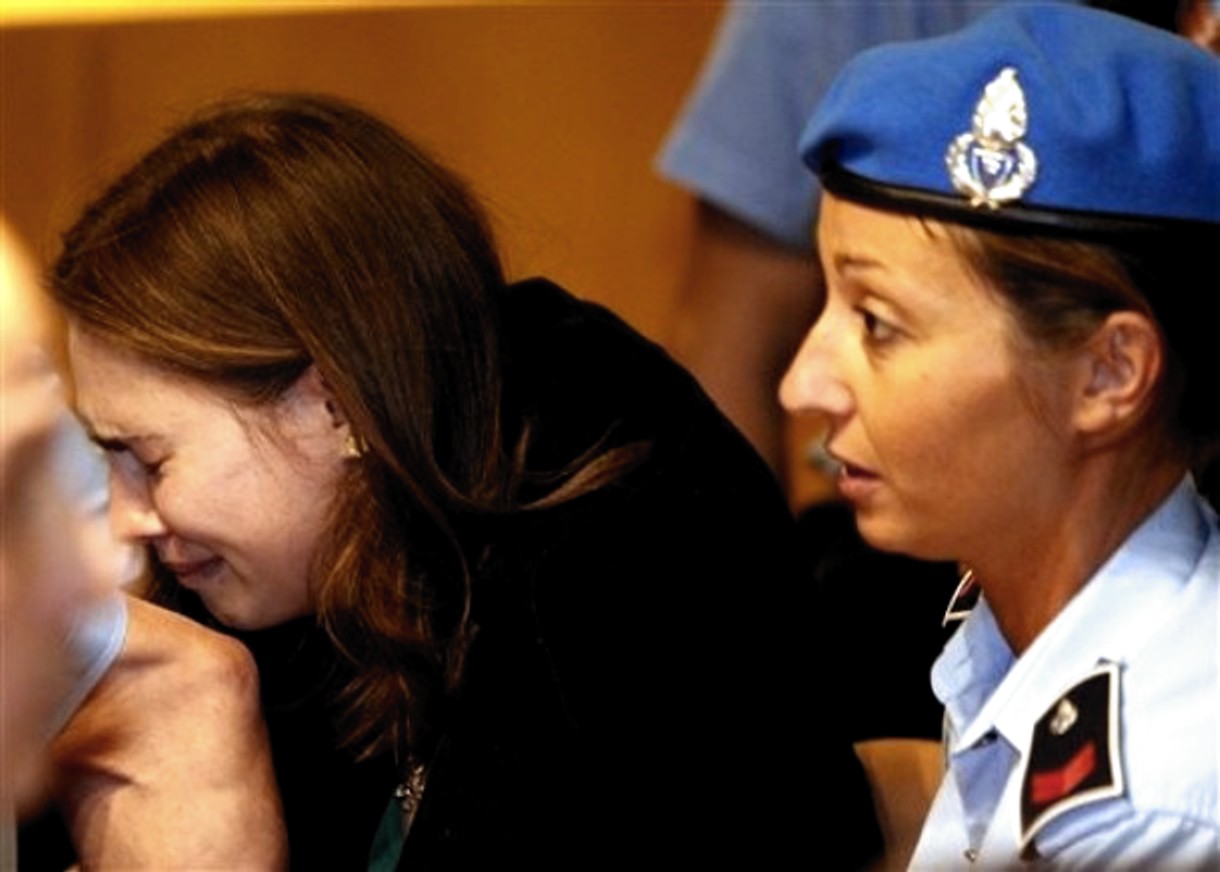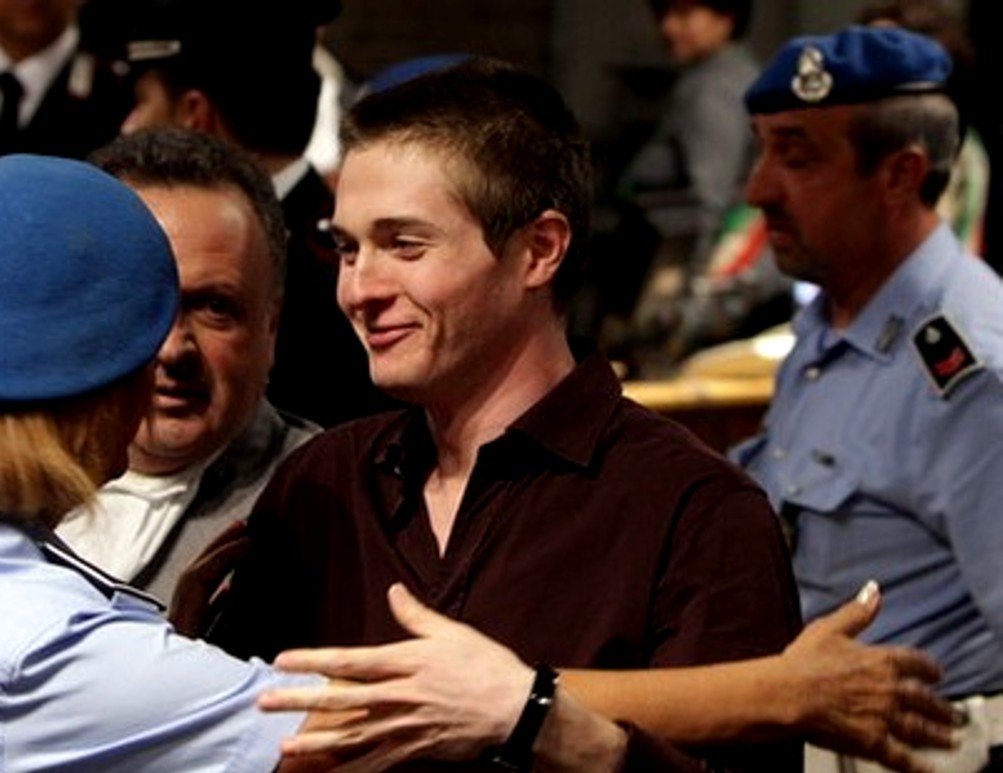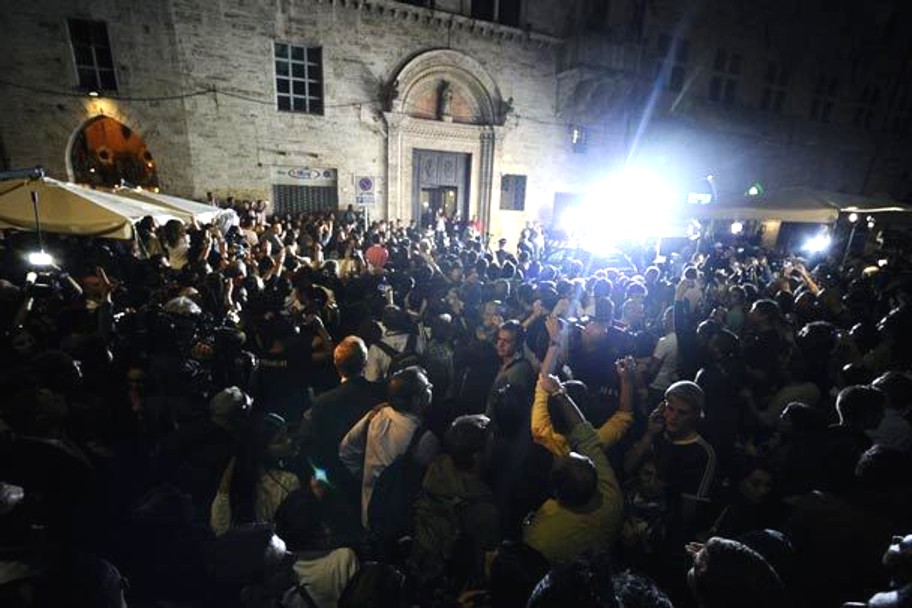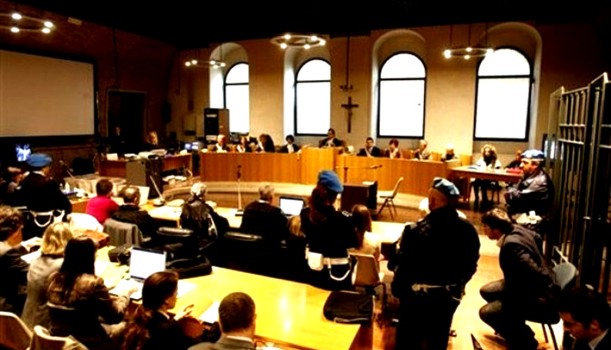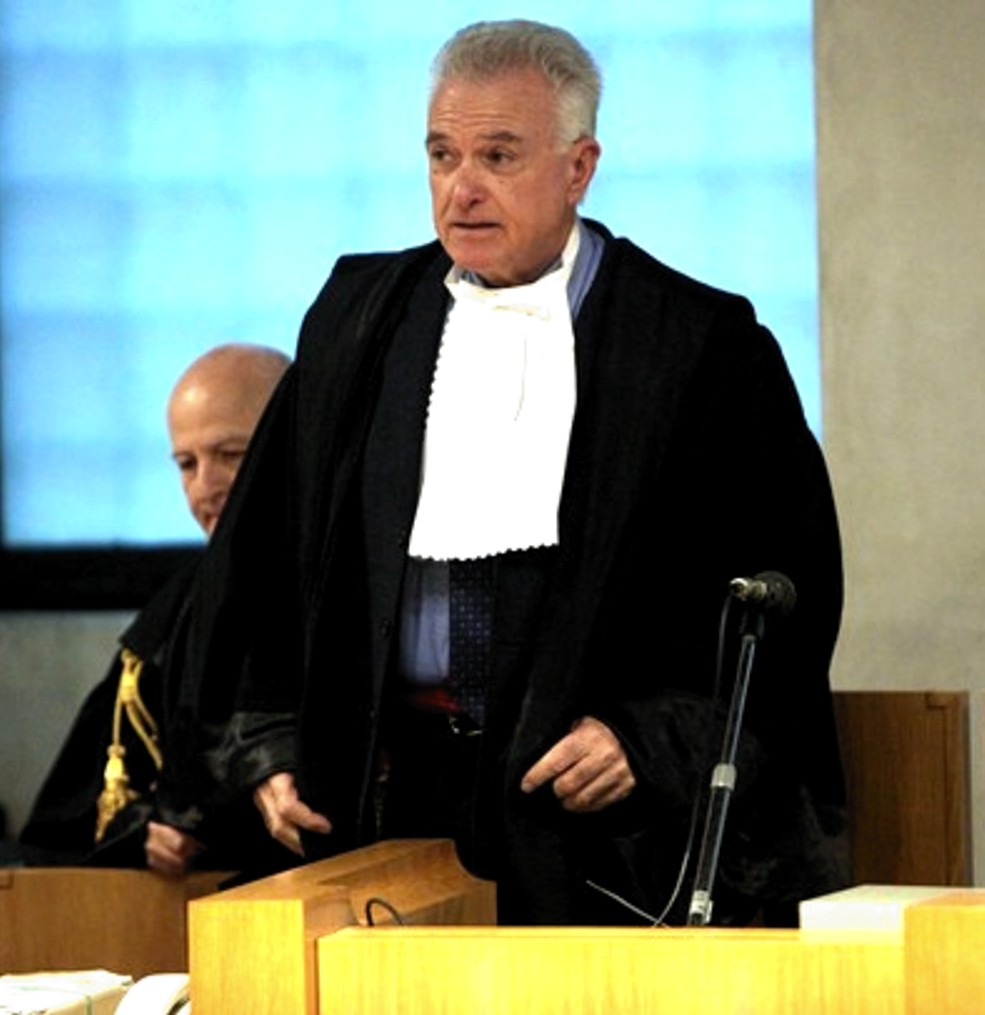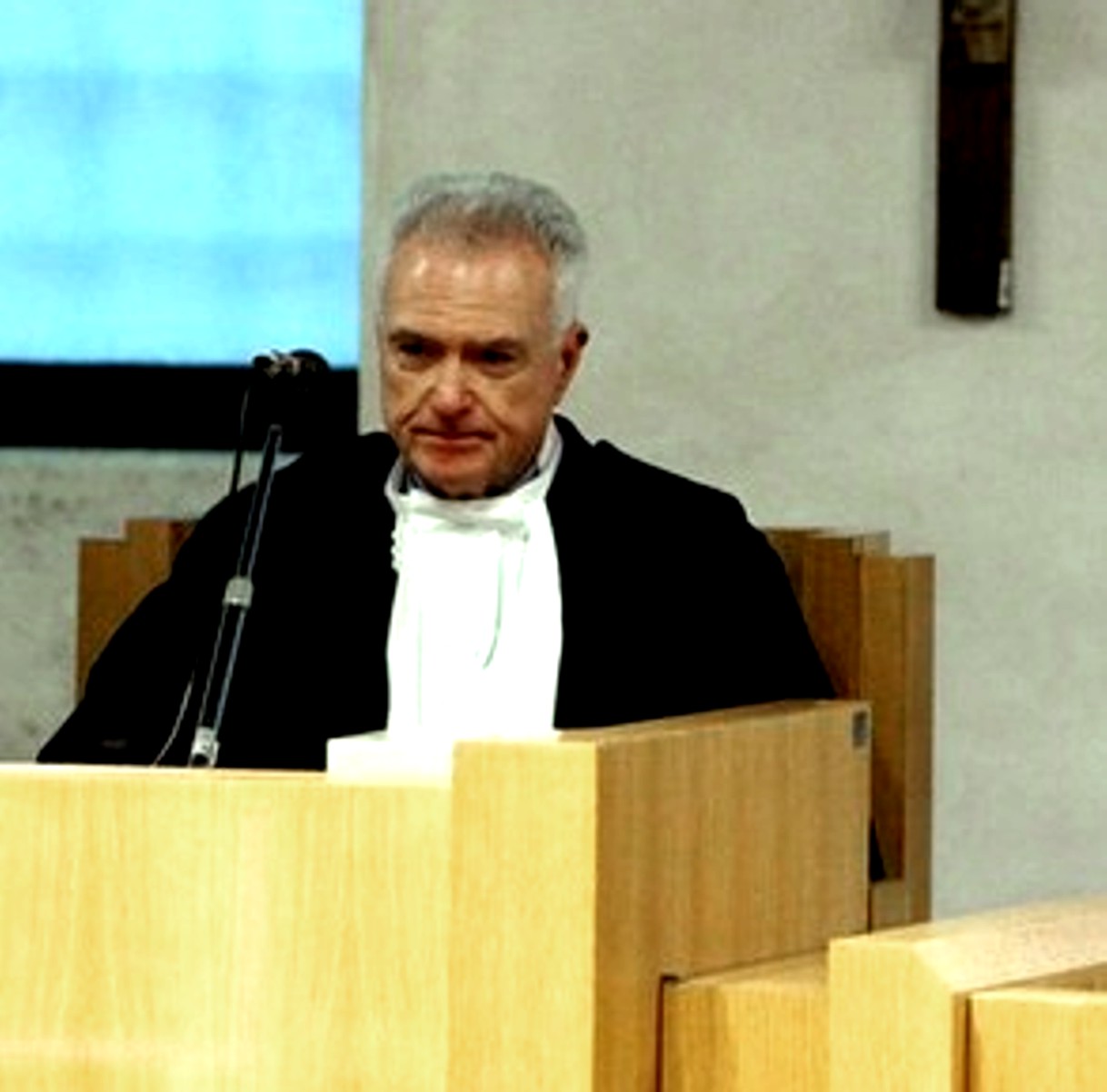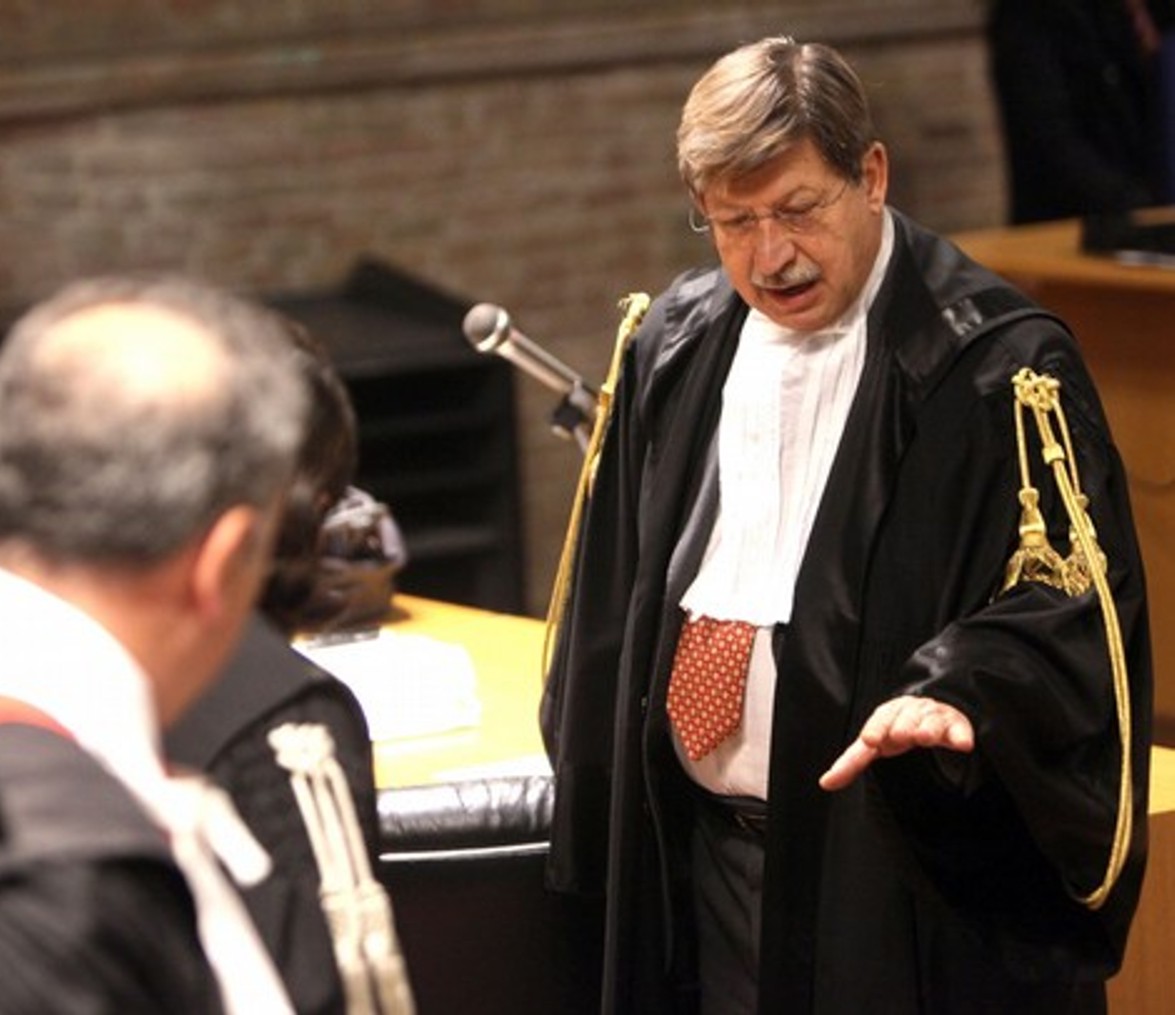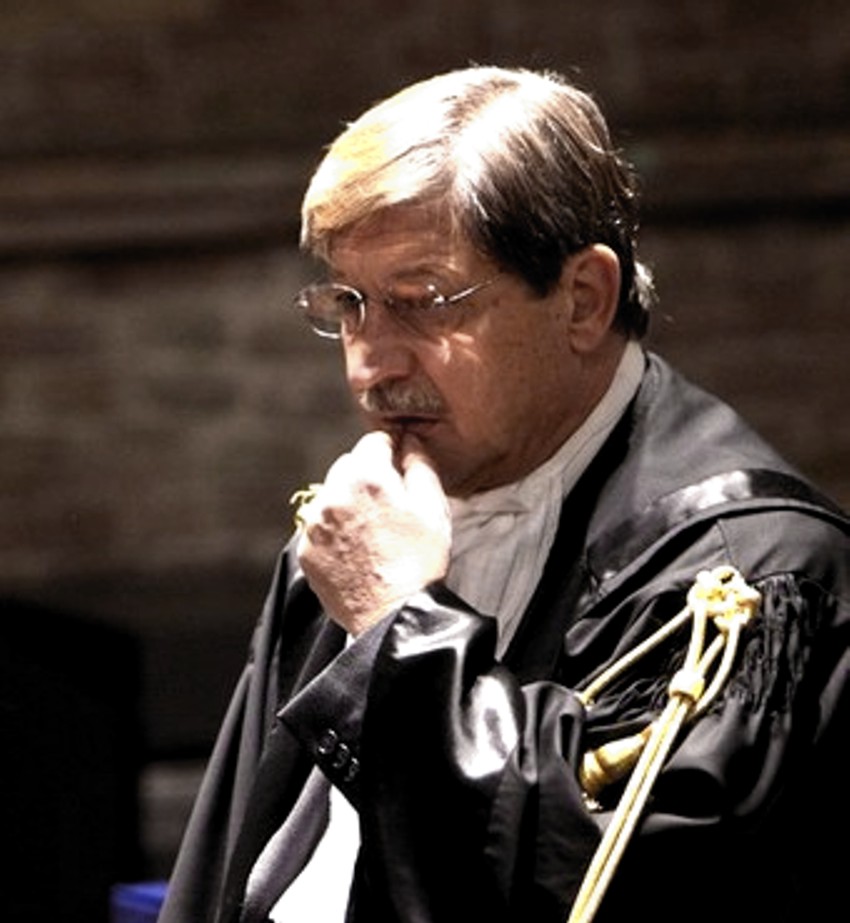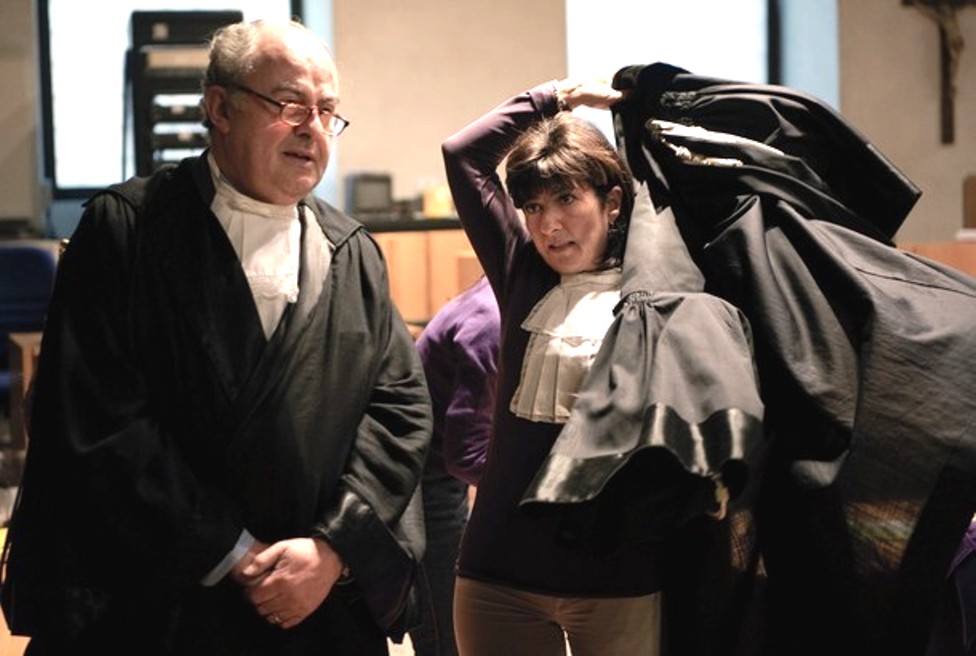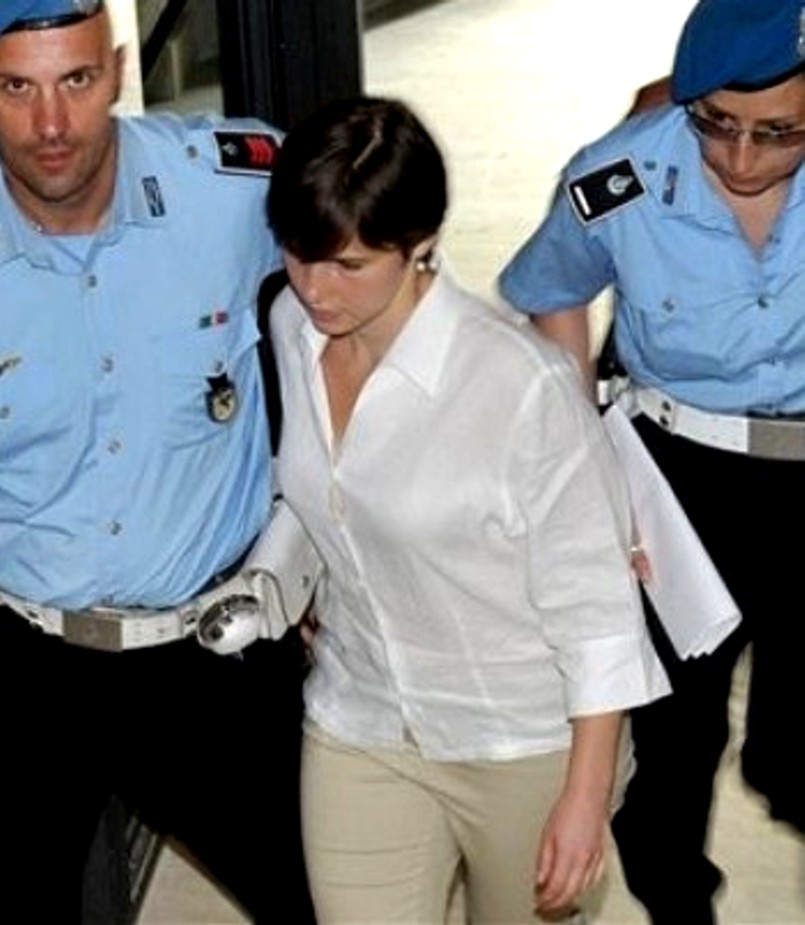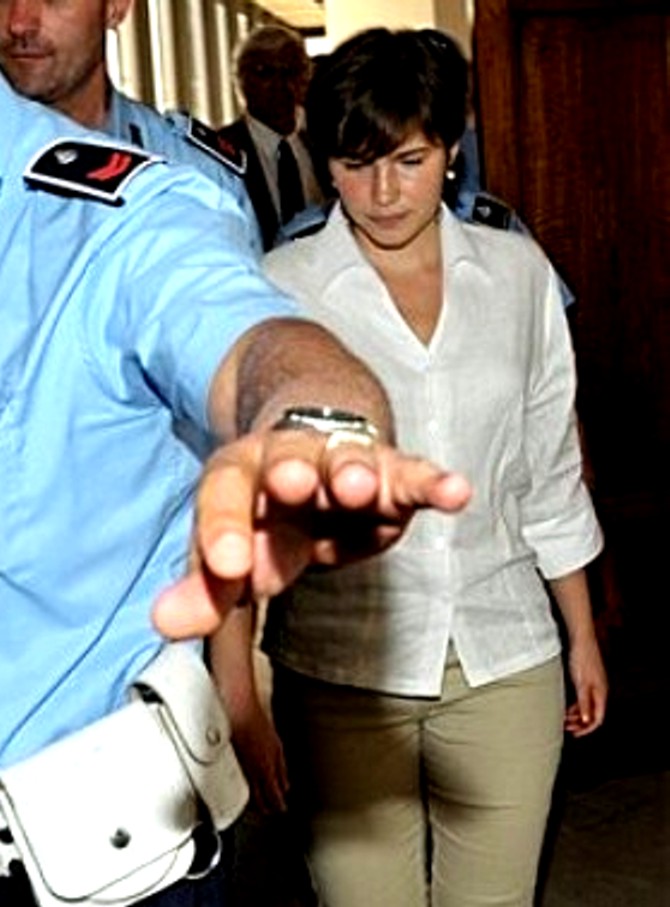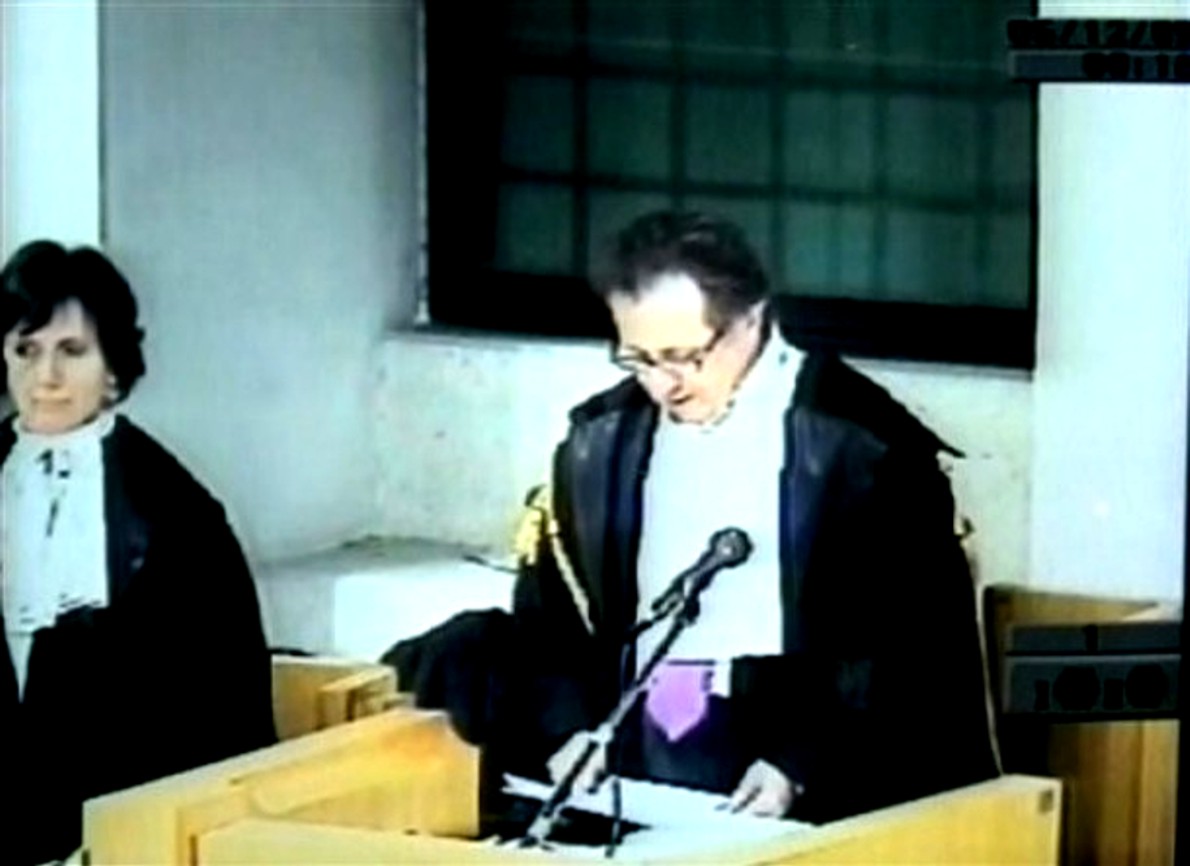
Category: The judiciary
Thursday, August 02, 2012
Dissecting The Hellmann Report #3: How Zanetti & Hellmann Bizarrely Try Discredit Witness Curatolo
Posted by Cardiol MD

[Stone steps Meredith and all three accused maybe used on the night; left and at bottom, where witness sat]
Under the first post in this series dissecting The Hellmann Report, one of our percipient commenters suggested this:
The next portion in the series should likely be about the witnesses, I hope, and there we can marvel at Hellmann’s discourses on the functioning of the human memory.
Was our commenter ever right!
On page 32 of the PMF English language version of “Sentence of the Court Of Assizes Of Appeal Of Perugia (Presided Over By Dr. Claudio Pratillo Hellmann)” this is written:
The presence of Amanda Knox and Raffaele Sollecito in Piazza Grimana between 9:30 PM and 11:30 PM on November 1 was, in fact, reported solely by the witness Curatolo, whose reliability this Court very much doubts for the following considerations.
In the first place, the deterioration of his mental faculties, from his way of life and his habits. revealed by his answers before this Court in the course of his testimony (hearing of March 26, 2011) resulting from his way of life and his habits
Realisation of what Hellmann/Zanetti were “constructively” doing there stunned me. They are exposing both a lack of logic and prejudice against a witness.
A necessary logical preamble to my realisation goes as follows:
- 1. Massei had stated that Antonio Curatolo’s declarations have “been established to be reliable” [MASSEI p.358 of 397 [28th of 42 total Curatolo references]].
2. Hellmann/Zanetti stated that “..this Court does not recognise the statement made by the witness Curatolo as credible”¦ [Hellmann/Zanetti p35 of 95 [5th of 18 total Curatolo references]]
3. In American common-law appellate courts do not rehear the facts of the case. Appellate courts focus on questions of law, NOT on questions of facts as their trial-courts do.
The American appellate judges don’t presume to supersede the people who were there, and who watched the witness’s demeanour and surrounding activity, in 4-D (3-D + Time), with sights, sounds, cadences, pauses, pronunciations, intonations, and yes, “¦smells, in addition to, and supplementing, the 2-D pieces of paper, containing only the words they apparently spoke, but not containing the way they spoke them, let alone the scene before the court.”
The American appellate judges want only to know whether the law was applied accurately.
Those American appellate courts overrule a trial court decision only if a very important legal error was made in the trial court.
In some cases, the American appellate court judges might believe that the outcome of the trial court should have been different, but if no legal errors were made, they will not overrule the lower court.
The American appellate judges make their decisions based only on legal arguments of how the law should be applied and interpreted.
Our learned English & Welsh Common Law (E&W) correspondent has explained to us that E&W law permits Appellate introduction of fresh evidence, which could include new evidence re rain and buses, although Massei had already considered evidence on those subjects.
E&W Law would not have allowed Appellate re-examination of Curatelo.
4. As we all know, and have discussed in some detail, Italian law is significantly different but Dr Galati is apparently outraged by the conduct and Motivazione of Hellmann/Zanetti.
Dr Galati has lodged a strongly-worded Appeal of Hellmann/Zanetti’s verdict, alleging that the scope of Hellmann/Zanetti was illegal and that they tried to run a whole new appeal trial.
Galati indicated in the appeal to Cassation that the Hellmann/Zanetti reveals “contradictoriness/contrariness and demonstrates manifest illogicality in the grounds for the judgement/reasoning report””¦
See also my previous post on the definition of “unreliable” [in the Hellmann Report] with reference to the witnesses Antonio Curatolo.
Although I can identify no specific reference by Dr Galati to the specific issue re Curatolo I wish to address, this one should have been included:
- i. “the deterioration of his mental faculties”, apparently between Curatelo’s testimony at the Massei hearing of March 28, 2009, and Curatelo’s the Hellmann/Zanetti hearing of March 26, 2011.
ii.Suppose Curatolo’s faculties really did deteriorate during those 2 years; maybe he was injured in an RTA, had a stroke, or developed a dementia.
What on earth has that got to do with Curatelo’s testimony back in 2009? It’s possible that Hellmann/Zanetti were implying that Curatolo’s “deterioration” was part of a continuum, and that as bad as he was, in their opinion, in 2007, 2009, and 2011, he had been, and still is steadily getting worse.
If that is their implication they would be committing 2 cardinal errors of logic ““ the interpolation error, and the extrapolation error.
Of course, giving their words their plain-meaning, Hellmann/Zanetti could be implying acceptance of the Massei’s statement that Curatolo’s 2009 testimony was reliable ““ but they obviously do not intend to imply that.
iii. Maybe Hellmann/Zanetti can get away with dismissing Curatolo’s testimony to Massei “presuming to supersede the people who were there, and who watched the witness’s demeanour and surrounding activity, in 4-D (3-D + Time), with sights, sounds, cadences, pauses, pronunciations, intonations, and yes, “¦smells, as well as the 2-D pieces of paper, containing only the words they apparently spoke, but not containing the way they spoke them, let alone the whole scene before the court. ”
I hope not, but with this “deterioration” allegation, there is no apparent (even an inadmissible one) professional expert opinion in evidence, and with Hellmann/Zanetti’s gratuitous cause-and-effect theory: “resulting from his way of life and his habits “, Hellmann/Zanetti overstep, and reveal their ignorance, arrogance, and incompetence.
Finality, in Anglo-American common law, is the concept that certain disputes must achieve a resolution from which no further appeal may be taken, and from which no collateral proceedings may be permitted to disturb that resolution.
Does Italian law really allow this 2-years-later Appeal-rehash of witness testimony and criticisms, on the grounds that the witness’s memories have faded since he first testified? I hope not.
Isn’t it normal for memories to fade with the passage of time?
Does that fading justify dismissal of the original testimony?
A principle of Anglo-American Common Law deeply embedded in it - Finality - would be out-of-the-window if lawyers could just keep repeating their questions until the witness gives them what they want.
Between their substitution of “certainty” for “reasonable-doubt” and their would-be eternal-postponement of finality Hellmann/Zanetti could shoot their legal system out of the courts.
Hellmann/Zanetti’s treatments of Curatolo’s testimony, alone, is a disaster. They should be thrown-out.
Hellmann/Zanetti’s subtext seems to be that Curatolo is merely an ignorant, illiterate, bad smelling, unkempt, dirty, ugly-old-tramp, daring to testify as to what he observed, to the detriment of two knowledgeable, educated, sweet-smelling, tidy, clean, attractive, young, innocent children.
Isn’t it far more certain, Hellmann/Zanetti seem to think, that the testimony of Curatolo is false testimony, and that the false testimony of these charming young children is not really false testimony because the Devil Prosecutors made-them-say-it.
If I analysed that whole section it would be very long.
If you are not yet familiar with them, you should read in conjunction with this series the posts by one of my lawyer colleagues on TJMK. James Raper, explaining the strength of the prosecution case and how hard it is to challenge legitimately.
See here and here. Also here by another of my lawyer colleagues, SomeAlibi.
[Below: witness said he and perps sat on benches at left; Meredith’s house far left, steps far right]

Wednesday, June 06, 2012
Action On Dr Galati’s Appeal To The Supreme Court Today Moved Ominously Closer
Posted by Peter Quennell
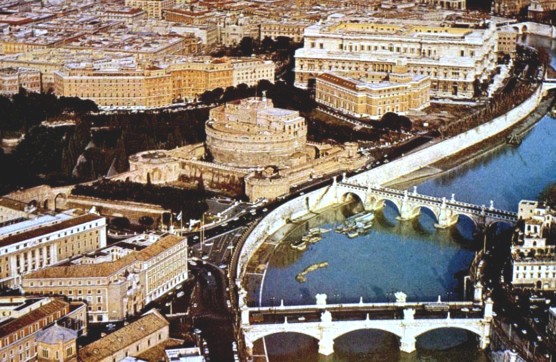
[Italy’s Supreme Court of Cassation is the large structure at right background]
The ANSA news service is reporting today that Dr Galati’s appeal was formally accepted by the Supreme Court on 15 May.
The case has just been assigned to the First Criminal Division of the Supreme Court which is responsible for appeals involving murder. A hearing and outcome which could involve the appeal being punted back to Perugia to be done again properly might be expected in about seven months.
Still no word from Sollecito or Knox or their teams about the exceptionally tough appeal Dr Galati filed against Judge Hellman’s interim verdict releasing them. Our Italian lawyers are surprised that there has been no announcement of any new legal help.
Do the still-accused or their families understand what is about to hit them? Cassation appeals are considered very specialised and certain Rome lawyers make a good living doing nothing but handle them.
Dr Galati was a deputy chief prosecutor at the Supreme Court and would seem to have the Knox and Sollecito teams who are inexperienced at that level thoroughly out-matched. If Knox fails to appear at any appeal trial re-run she would lose the advantage of personalising her own plight with the help of her flash-mob in the court.
In Italy there is enormous suspicion that politics and money played roles in bending the outcome the last time around. The prosecution clearly felt that, and there seems a good chance the full story will not remain hidden.
We also hear that the continued rabid postings of Curt Knox’s hatchetmen are increasingly under the microscope. No sign their campaign does anything but hurt. It sure put real resolve into this appeal.
Monday, October 03, 2011
Knox And Sollecito Declared Not Guilty But With Angry Booing Outside The Courtroom
Posted by Peter Quennell
Sunday, June 19, 2011
The Massei Sentencing Report For Knox And Sollecito: Part 1 Of A Summary In 4 Parts
Posted by Skeptical Bystander
Why This Long Summary
The full Massei Report can be found here.
The wiki page controversy surrounding the murder of Meredith Kercher rages on in a tiny corner of the online universe, here is our own contribution to the debate.
It is a 4-part summary of the Massei report, the document that sets forth and explains the Court’s reasons for unanimously convicting Amanda Knox and Raffaele Sollecito for their role in the murder of Meredith Kercher, Knox’s roommate, after a long, thorough and fair trial.
Please click here for more
Saturday, December 18, 2010
The Appeal’s Set Limits: What The Judges Allowed Today And Didn’t Might Tell Us A Lot
Posted by TomM
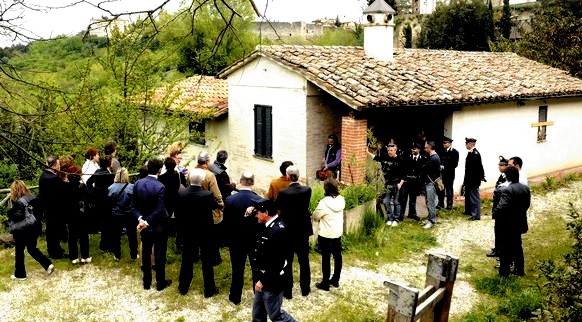
[Massei court deciding whether to buy spiderman theory; they didn’t]
1. The Context Of These Remarks
The judge ruled on the appeal’s inclusions and exclusions today. I’ll summarise what they are and how American courts might have differed.
I really do not understand why the defense and the family are so happy with this review, which is very limited and not complete in any sense - other than, perhaps, the “any port in a storm” phenomenon.
From my view in the bleachers, there are way more risks to the defense than to the prosecution from Saturday’s rulings.
2. What’s Allowed In Italian Appeals V. American
As a California lawyer familiar with trials and appeals in my state, watching the Meredith Kercher murder trial wind its way through the Italian legal system has been a learning experience.
It is a system with more protections than the one I know first-hand. The case is now in its first appeal phase, and proceeds far differently from the way it would in the US.
- If Knox and Sollecito had been convicted in an American court (which an American court would have had no difficulty in doing) less helpful presumptions would be applied to their appeal.
- In Italy they are convicted, and for that reason they are imprisoned and the visitation privileges they had before the jury’s verdict have been reduced. But for purposes of weighing the evidence in the appeal, they are presumed innocent.
- In the US, the court of appeal would not presume them innocent or guilty; it would regard them as having been adjudged guilty.
- In Italy, they can ask for the court of appeal to hear testimony from new witnesses and seek to introduce additional evidence.
- In the US, the appeal would be on the basis of the clerk’s and reporter’s transcripts of the trial. In the US the jury at the original trial would have been instructed that if an item of evidence can be interpreted two ways, one favoring guilt and one favoring innocence, they should accept the interpretation that favors innocence. But not so on appeal; the court of appeal would interpret all the inferences from the evidence in the light most favorable to the prosecution.
- An American court of appeal would not consider an attack on the credibility of a witness unless the testimony was such that no reasonable person would believe the testimony.Thus, an attack on the testimony of Curatolo would have no chance of success on appeal. In fact, jury instruction in the US would give the jury blessing to believe him even absent disco buses running that fatal night.
From a form jury instruction on how to judge witness credibility:
“Do not automatically reject testimony just because of inconsistencies or conflicts. Consider whether the differences are important or not. People sometimes honestly forget things or make mistakes about what they remember. Also, two people may witness the same event yet see or hear it differently.”
The Italian appeal is described as a “trial de novo”.
- In common law jurisprudence, a trial de novo is simply a new trial, and the jury in a new trial would not even be told of the existence of the first trial. It would be done as if the first trial never happened.
- Not so in Italy. The jury and lay judges have full access to the case dossier, the Massei Motivazione, and the briefs of the parties. They decide which parts of the case should receive new evidence, and the parts where none is needed. If that were not the case, they would not know how to respond to the defense requests.
3. Tellingly, What Court Has NOT Re-opened
1. Staging Of Burglary
It is significant that there is no re-visit on the staging of the burglary. This charge is not just one of the things used to prove the murder, it is also a separate charge which does not require that a person also have participated in the murder.
Let’s suspend disbelief a moment. Suppose AK and RS had not been present during the murder, having ducked out briefly to get more drugs, but returned to discover Meredith’s body.
Suppose they thought they would be suspects because they had let Rudy in and feared they would be blamed, so they staged the burglary to divert suspicion from themselves. In this hypothetical situation, they are still guilty of staging a burglary even if they didn’t otherwise participate in the crime.
So, what to make out of the fact that no further evaluation will be made of the staging?
This seems like the easiest of the charges to prove and the most difficult to defend. Staging is a recognized phenomenon in criminal investigations and the defense expert did not fare well under cross-examination. I don’t see how the court would reverse the judgment on this issue given the state of the record.
2. Collection Of DNA
Defense criticized the way the dna was collected from the bidet, but there will be no review of that evidence - or of any other of the mixed blood/dna evidence - only the knife and the bra clasp.
If the appellate jurors’ inclination were to think there is reasonable doubt on the dna, there is plenty of defense expert testimony to hang that hat on. That only two of the exhibits will be studied shows that they do not question the work of the scientific police as a whole.
4. The Pattern Of Sorts In These Rulings
From my own experience, I firmly believe that Hellman has not made up his mind on the final outcome. That doesn’t mean he doesn’t know what he thinks the jury will do with the case.
He clearly knows the case, and I think he knows if there are areas in Massei’s reasoning that have vulnerabilities (not necessarily fatal) that could attract attention in the Court of Cassation.
I think he knows whether the prosecution’s case is a house of cards, or if it is a good case with some curable cosmetic flaws.
To me, the rulings look like the judge has reviewed the case, thinks it is fundamentally sound, and believes it will be backed up by unbiased expert opinion - and if it doesn’t, he will assess what impact that has on the case.
The issue with respect to the scientific police is not that they were biased in the sense of falsifying evidence to wrongfully convict, but that the video of the crime scene investigation showed non-textbook acts, Stefanoni didn’t leave a complete paper trail in testing the knife, and they failed to collect and correctly bag the bra clasp at the beginning.
All of which left an opening for the defense to claim the dna evidence is suspect. There is a reason why teachers don’t let students grade their own papers, I think that concept is behind Hellman’s decision to seek an unbiased review of these two items.
5. No Signs Of Exoneration In Rulings
If Rudy Guede testifies and gives a believable narrative, it may not matter what the two dna reviews say, and it might also undermine the jurors’ inclination to accept the theory of remorse from the covering with the quilt that persuaded Massei to reduce the sentence.
An increased sentence is not out of the question.
As I said at the top, I really do not understand why the defense and the family are so happy with this review, which is very limited and not complete in any sense - other than, perhaps, the “any port in a storm” phenomenon.
The bra clasp evidence is not going to go away, and there is the risk that increased technical sophistication could result in identifying a complete dna profile of Amada Knox on it. If they disassemble the knife, there could be abundant blood between the handle and the blade.
Again, from my view in the bleachers, there are way more risks to the defense than to the prosecution from Saturday’s rulings.
Wednesday, November 24, 2010
1st Appeal Session: Judge Claudio Pratillo Hellmann And Prosecutor Giancarlo Costagliola
Posted by Peter Quennell
Sunday, October 31, 2010
Corruption Of Appeal: Angry Top Criminal Judge Chiari Is Blatantly Forced Aside
Posted by Peter Quennell

Umbria’s top criminal judge Sergio Matteini Chiari
Very Dirty Business
Only one month ago Umbria’s top criminal judge Sergio Matteini Chiari was to preside.
Now a very angry Judge Chiari has been forced aside with no public explanation from Chief Judge De Nunzio [image below] as to why.
A wildly wrongly qualified judge, Hellmann, a business judge with just two criminal trials in his past, both fiascos, mysteriously takes his place.
Rumors of foul play are appearing in the Italian media. Has Chief Judge De Nunzio been leaned upon politically? Do big bucks or rogue masons have any role in this?
Please click here for more
Monday, September 20, 2010
Explaining The Massei Report: All Judges, Lawyers And Witnesses At Trial Jan-Dec 2009
Posted by Storm Roberts
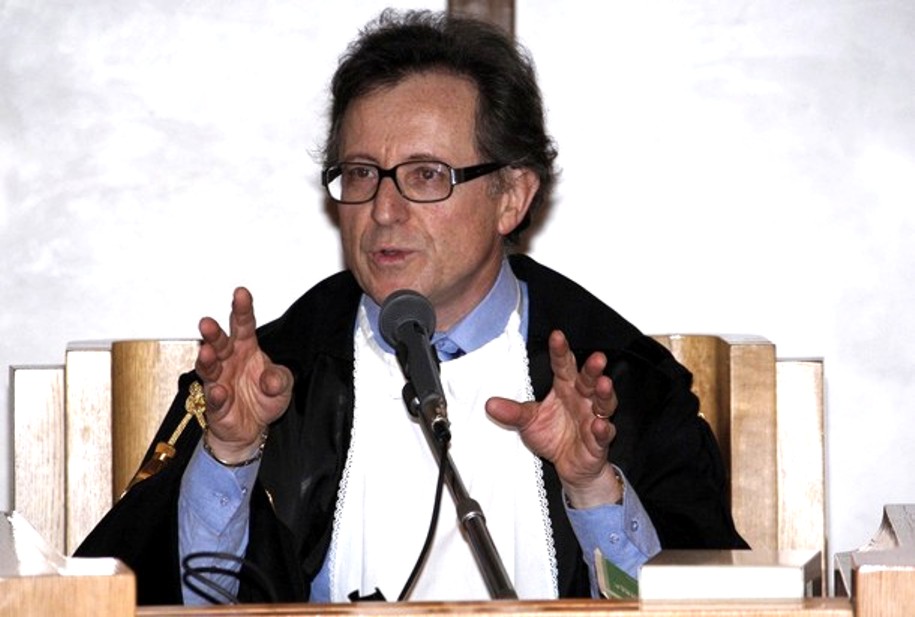
[Above: Dr Giancarlo Massei, the president of the Court]
Our intention with this new series of posts is to show how thorough the trial was, and how compelling the Massei Report on the grounds for the Knox-Sollecito sentence is.
At the beginning of the trial, the witness counts were considerable: approximately 90 for the prosecution, 60 for the civil plaintiffs, 90 for the defence of Raffaele Sollecito, and 65 for the defence of Amanda Knox.
However, a large number of witnesses for both Amanda Knox and for Raffaele Sollecito were removed from the witness listing. Thus the actual number of people testifying was lower than originally expected.
Here is a comprehensive list I have compiled, made by going through the Massei Report, picking out the witnesses, and noting what they testified about. If I had the information available, I have noted where a witness was specifically called by the defence of either of the then defendants.
Officers Of The Court
- Judges: Dr Beatrice Cristiani and Dr Giancarlo Massei, the president of the Court.
- Prosecutors: Public Ministers Dr Manuela Comodi and Dr Giuliano Mignini.
- Interpreter for Amanda Knox: Dr Anna Baldelli Fronticelli.
The Legal Teams:
- For the family of Meredith Kercher: Francesco Maresca and Serena Perna.
- For Diya “Patrick” Lumumba: Carlo Pacelli.
- For Aldalia Tattanelli (the owner of the house): Letizia Magnini.
- For Amanda Knox: Luciano Ghirga and Carlo Dalla Vedova.
- For Raffaele Sollecito: Giulia Bongiorno, Daniela Rocchi and Luca Maori.
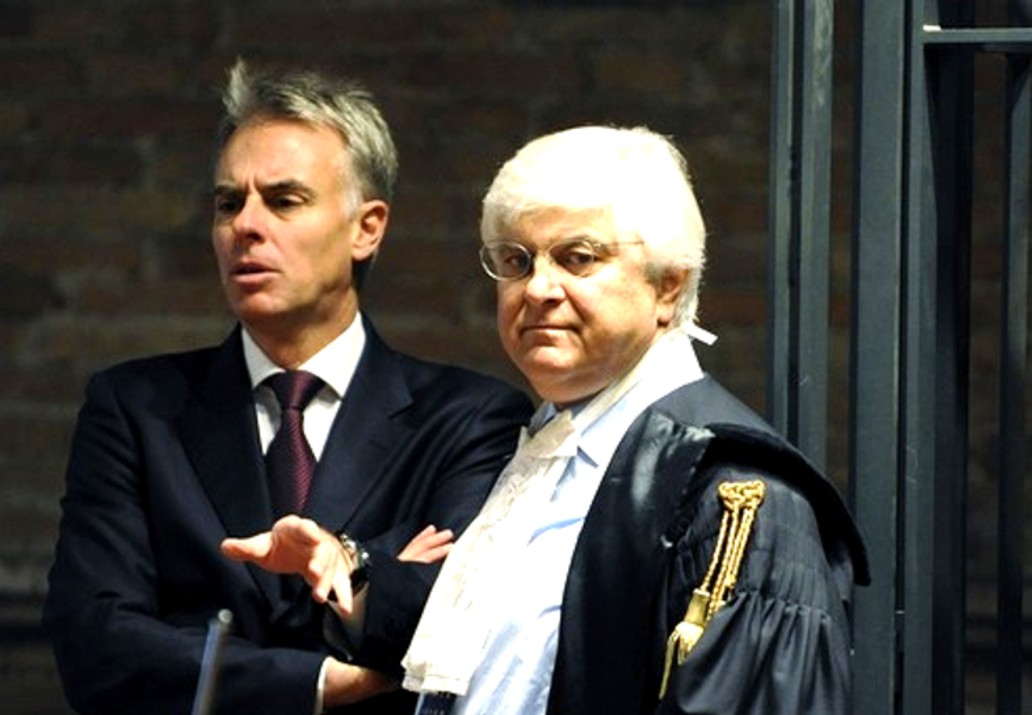
[above: Amanda Knox’s legal team]
Witnesses
The following is a list of witnesses and a brief note as to the evidence they presented. I am not detailing their arguments here, merely indicating the areas the witnesses were heard in. For full details of the evidence and the court’s arguments please read the Massei Report in full and the summaries coming up.
- Amanda Knoxtestified while not under oath at the request of her defence and the legal team representing Diya Lumumba. Her testimony was heard on 12th and 13th June 2009. Raffele Sollecito made a couple of interventions from his seat beside his three lawyers, but he did not get up on the stand.
- Mrs. Elisabetta Lana and her son, Alessandro Biscarini. They discovered two mobile phones, both belonging to Meredith Kercher (one was registered to Filomena Romanelli, Meredith’s flatmate), in their garden at Via Sperandio.
- Dr. Filippo Bartolozzi - at the time Manager of the Department of Communications Police for Umbria - Dr. Bartolozzi received the mobile phones from Mrs Lana, the first at approximately 11.45 to 12.00hrs on 2nd November 2007, the second at approximately 12.15 to 12.20 hrs. He traced the first phone to Filomena Romanelli and, at noon, despatched two officers to her address to investigate why her phone was in Mrs. Lana’s garden.
- Inspector Michele Battistelli and Assistant Fabio Marzi - the two officers despatched by Dr. Bartolozzi. They arrived at 7 Via della Pergola at a little after 12.30 hrs - they found Amanda Knox and Raffaele Sollecito sitting outside the house. They gave evidence about the circumstances leading up to the discovery of Meredith’s body and with regards to securing the scene whilst awaiting the Carabinieri and Scientific Police.
- Filomena Romanelli who was Meredith’s flatmate gave evidence regarding the phone she had lent to Meredith. She also detailed when she had moved into the flat at 7 Via della Pergola and the living arrangements. She told of her plans for the 2nd November and how a worrying phone call from Amanda Knox led to her calling her back and returning to her home earlier than planned. A key point of Ms. Romanelli’s evidence was her disagreement with Amanda Knox over when Meredith locked her door - Ms. Romanelli stated that Meredith had only once locked her door and that was when she had returned to England for a few days.
- Paola Grande, Marco Zaroli and Luca Altieri - the other young people who were at the property when Meredith’s body was discovered. Mr. Altieri broke down the door to Meredith’s room.
- Laura Mezzetti - the fourth flatmate in the upstairs flat at number 7 Via della Pergola. She testified with regards to the living arrangements and also that Amanda Knox is an early riser, a “morning person”.
- Robyn Butterworth, Amy Frost, Sophie Purton and Nathalie Hayward - Meredith’s friends from England. They testified as to when they last saw Meredith and described the behaviour of Amanda Knox and Raffaele Sollecito at the Police Station in the evening of 2nd November 2007. They also testified that Meredith had no plans after returning home at around 21.00 hrs on 1st November other than to study and have a rest as they had been out late the previous night and believed that they had classes the next day. Meredith’s friends did not know of Rudy Guede and had not heard Meredith mention his name.
- Giacomo Silenzi, one of the young men living in the flat underneath Meredith’s flat. He was Meredith’s boyfriend.
- Stafano Bonassi, Marco Marzan and Riccardo Luciani the other tenants of the downstairs flat. Along with Mr. Silenzi they testified as to the the interactions between themselves and the girls upstairs, the gatherings they held, the fact that Rudy Guede was known to Amanda Knox. They testified as to Rudy Guede’s actions at their house. They gave evidence of having met or known of Raffaele Sollecito and his relationship with Amanda Knox.
- Giorgio Cocciaretto a friend of the young men in the downstairs flat testified with regards to knowing Rudy Guede through playing basketball and having seen him at the 7 Via della Pergola house when both Meredith and Amanda Knox were present.
- Rudy Guede availed himself of his right not to participate in the trial of Amanda Knox and Rafaelle Sollecito. Judge Massei details Rudy Guede’s involvement based upon the evidence available in order to complete the reconstruction of events of 2nd November as he was charged alongside Amanda Knox and Raffaele Sollecito.
- Marta Fernandez Nieto and Caroline Espinilla Martin - two young ladies living in the flat above Rudy Guede, they testified than on the night of 31st October they had been in the presence of Rudy Guede and that the only girl they saw him dance with was a “blonde girl with long smooth hair”.
- Gioia Brocci from the Questura of Perugia who testified with regards to a trail of shoe prints leading from Meredith’s room to the exit of the flat getting fainter as they went. Ms. Brocci also testified as to the lack of signs of climbing on the wall below Filomena Romanelli’s window. She also collected evidence from the bathroom next to Meredith’s room.
- Sergeant Francesco Pasquale testified as to the possibility of breaking into the flat though the window in Filomena Romanelli’s room. Sergeant Pasquale was a consultant for the defence.
- Maria Antonietta Salvadori Del Prato Titone, Paolo Brocchi, Matteo Palazzoli and Cristian Tramontano testified with regards to previous incidents involving or possibly involving Rudy Guede.
- Edda Mellas , Amanda Knox’s mother. She testified as to communications with her daughter on the 2nd November amongst other things.
- Antonella Negri a teacher at the University who taught Amanda Knox and who testified as to her diligence as a student.
- Francesco Sollecito, father of Raffaele Sollecito. He testified as to his son’s character and about his communications with his son. He also spoke of his son’s relationship with Amanda Knox.
- Antonio Galizia, Carabinieri station commander in Giovinazzo, the Sollecito family’s home town. He testified that in September 2003 Raffaele Sollecito was found in possession of hashish.
- Jovana Popovic testified as to the presence of Amanda Knox at Raffaele Sollecito’s home at two points in time on the evening of 1st November 2007.
- Diya “Patrick” Lumumba was Amanda Knox’s employer at “Chic”. He testified that he has sent her a text message excusing her from work on the evening of 1st November.
- Rita Ficcara Chief Inspector of the State Police - to whom Amanda Knox delivered a written statement composed whilst she was awaiting to be transferred to Capanne Prison.
- Antonio Curatolo - Mr. Curatolo testified as to having seen Amanda Knox and Raffaele Sollecito at the basketball court in front of the University (the Piazza Grimana) in the evening of 1st November 2007.
- Maurizio Rosignoli - who runs a kiosk in the Piazza - testified with regards to the timing of buses at the Piazza Grimana thus corroborating times in Mr. Curatolo’s evidence.
- Alessia Ceccarelli - who worked managing Mr. Rosignoli’s kiosk - gave evidence as to Mr. Curatolo’s presence in the Piazza.
- Marco Quintavalle, who runs the shop “Margherita Conad”, testified he had seen Amanda Knox at 07.45 hrs on 2nd November, she was waiting for him to open his shop, she went to the section of the store that had items such as groceries, toilet paper and cleaning products but he did not serve her at the till so could not specify what she bought if anything. He testified that he knew Raffaele Sollecito as he was a regular customer.
- Officer Daniele Ceppitelli gave evidence with regards to the 112 calls made by Raffaele Sollecito at 12.51 and 12.54 hrs on 2nd November. In these calls Raffaele Sollecito declared that nothing had been stolen from the flat.
- Nara Capezzali, Antonella Monacchia and Maria Ilaria Dramis gave evidence of unusual sounds and activity coming from the area around 7 Via della Pergola - namely a scream and the sound of running footsteps.

[one of Sollecito’s three lawyers with Sollecito]
Expert Witnesses
- Dr. Lalli, the Coroner, he performed the post mortem and ascertained the cause of death and a “time window” when death was likely to have occurred. He put the time of death between 20.00 hrs on 1st November 2007 and 04.00 hrs the following day.
- Dr. Domenico Giacinto Profazio was head of the Perugia Flying Squad at the time of Meredith’s death. He gave evidence regarding the investigative procedures and safeguards including the physical security of the property.
- Dr. Marco Chiacchiera, deputy director of the Perugia Flying Squad also gave evidence regarding the scene and investigation.
- Monica Napoleoni, Deputy Commissioner of the State Police gave evidence regarding the scene and investigation. She also testified as to Raffaele Sollecito’s desire to remain with Amanda Knox.
- Mauri Bigini a chief inspect at the Flying Squad confirmed the evidence given by Profazio and Napoleoni.
- Armando Finzi a chief inspector at the Flying Squad gave evidence regarding the examination of Raffaele Sollecito’s flat and the collection of the knife which is now termed “the Double DNA Knife” (Exhibit 36).
- Stefano Gubbiotti and Zugarini Lorena confirmed the evidence regarding the search of Raffaele Sollecito’s flat.
- Dr. Giunta from the Scientific Police in Rome directed the detection of latent prints at the scene.
- Dr. Patrizia Stefanoni from the Scientific Police in Rome collected biological trace evidence for analysis. She also performed the analysis of DNA evidence and testified extensively on all aspects of DNA - from the background science, through the collection and the testing methods employed to the analysis.
- Professor Mauro Marchionni, Dr. Vincenza Liviero and Professor Mauro Bacci, the three consultants appointed by the Public Ministers to analyse the forensic medical evidence testified as to various aspects of Dr. Lalli’s report including the cause of death, timing of death, the sexual assault and the wounds. They reported on the degree of compatibility of the knife - Double DNA Knife, Exhibit 36 - with the wounds suffered.
- Professor Gianaristide Norelli, the consultant for the civil party, is a forensic police doctor. He testified with regards to the time and cause of death and the sexual assault against Meredith. He testified as to the degree of compatibility of the Double DNA Knife with the wounds suffered.
- Professor Francesco Introna, a consultant appointed by Raffaele Sollecito’s defence testified with regards to the forensic medical evidence (cause and time of death, the sexual assault). His opinion is that the murder was committed by one person and that the Double DNA Knife was not the weapon used to inflict the large wound on the left of Meredith’s neck. He hypothesised that Meredith was already undressing at the end of the day when she was surprised by her sole attacker who attacked from behind.
- Professor Carlo Torre, a consultant appointed by Amanda Knox’s defence testified with regards to the same areas as described above. In his opinion the Double DNA knife was not the knife used to inflict the large wound on the left of Meredith’s neck. He believed a stabbing from the front was the most likely dynamic, and he saw nothing that would lead him to believe there was more than one attacker.
- Professor Vinci, a consultant appointed by Raffaele Sollecito’s defence, he testified with regards to the stains on the bed sheet -which appeared to be made in blood, outlining a knife. Professor Vinci also testified with regards to footprints found in the flat.
- Dr Patumi, a consultant appointed by the defence of Amanda Knox, testified with regards to the neck wounds suffered and also with regards to the genetic evidence as detailed by Dr. Stefanoni.
- Professor Anna Aprile, Professor Mario Cingolani and Professor Giancarlo Umani Ronchi, all independent consultants appointed by the judge (GIP) at the preliminary hearing. Professor Aprile testified specifically on the question of the sexual assault, Professors Cingolani and Umani Ronchi again considered the evidence with regards to the cause and time of death and the compatibility of the Double DNA Knife with the large wound on the left of Meredith’s neck.
- Dr. Torricelli, the consultant for Meredith Kercher’s family, testified and gave her opinion on the genetic evidence as detailed by Dr. Stefanoni.
- Dr. Sarah Gino, a consultant appointed by the defence of Amanda Knox, testified and gave her opinion on the genetic evidence as detailed by Dr. Stefanoni.
- Professor Tagliabracci, a consultant appointed by Raffaele Sollecito’s defence, testified and gave his opinion on the genetic evidence as detailed by Dr. Stefanoni. He also gave evidence with regards to the effects of certain drugs.
- Marco Trotta, Claudio Trifici and Gregori Mirco officers of the Postal Police, gave evidence with regards to the seized computer equipment and also with regards to internet activity at the home of Raffaele Sollecito.
- Mr. Fabio Formenti, the technical consultant appointed by Raffaele Sollecito’s defence - observed the Postal Police’s analysis of the computer equipment.
- Dr Michele Gigli and Dr. Antonio D’Ambrosio, consultants appointed by Raffaele Sollecito’s defence, testified with regards to the computer and internet evidence.
- Chief Inspector Letterio Latella gave evidence with regards to mobile phones and how they pick up signals from base stations which cover certain areas, he also testified with regards to the call records of the mobile phones of the defendants, victim and others. He detailed how a connection to the network was picked up by the base stations and how the location of the phone can be approximated through knowing which base station was used. He was able to tell the court which connections to Meredith’s two phones were made from her own flat and which from Mrs. Lana’s garden.
- Assistant Stefano Sisani provided evidence with regards to both landline telephone services and mobile phone services.
- Bruno Pellero an engineer appointed by Raffaele Sollecito’s defence to give evidence with regards to telephonic communications.
- Dr. Lorenzo Rinaldi, Principal Technical Director of the State Police, director of the three sections which compose the Identity Division of the ERT, gave evidence regarding shoe prints and footprints (including those highlighted by the use of luminol.
- Chief Inspector Pietro Boemia, who worked alongside Dr. Rinaldi.
- Chief Inspector Claudio Ippolito a consultant who reported on shoe prints - appointed by the public minister.

[Background: the Judges and jury (lay judges) for the trial]>
Thursday, June 17, 2010
Decision On Who Will Be Amanda Knox’s Judge At Her Forthcoming Slander Trial
Posted by Peter Quennell
Above and below: Amanda Knox entering the court area less than an hour ago. The decision is due momentarily.
Our previous post on the slander trial was here. The Appeals Court should be announcing the decision on which judge right about now>
Added: ANSA and other Italian news services are reporting that Knox made one of the spontaneous statements the Italian law allows her, and that the decision on a judge will take another five days.
“I just wanted to defend myself”. So said Amanda Knox, back in court once more, this time for defamation. “I’m sorry that the matter has reached this point,’ said Amanda before the Court of Appeals in Perugia
The court will within another five days decide on the request of her defense team to replace the preliminary hearings judge, Claudia Matteini, for the trial of the Seattle student who is accused of slander against various police officers.
Thursday, March 04, 2010
Judges’ Sentencing Report Released In Perugia And It Is 427 Pages Long
Posted by Peter Quennell
Judge Massei is seen above on live TV from the court on the night he announced the verdict and sentence.
The sentencing report is four times the length of the Micheli report a year ago which itself was very detailed. It was made available to the media today on paper by the court in Perugia.
First take in the Italian media is by TGCom.
The judges of the Court of Assizes of Perugia lodged the grounds for the condemnation of Raffaele Sollecito and Amanda Knox for the murder of Meredith. All the issues raised in the process, it says, “demonstrate a comprehensive and unified whole, without gaps and inconsistencies”... The reasons for conviction of two defendants are contained in a voluminous file. It is 427 pages signed by the President of the Court Giancarlo Massei and assessor Beatrice Christians.
The motive is described in the report as essentially the thrill of the moment in helping Rudy with a sexual attack and while there was a predisposition there was no longer term intention.
Drugs are seen as having played a role.
Sollecito and Knox are apparently seen in the report as the knife wielders and one of them seems to have delivered the fatal blow.
We will be obtaining the report of course and arriving at our own English-language version in the next several weeks.
RIP poor Meredith. This has to be so tough on her family and her friends. We love this photo below. So trusting and so full of life.

